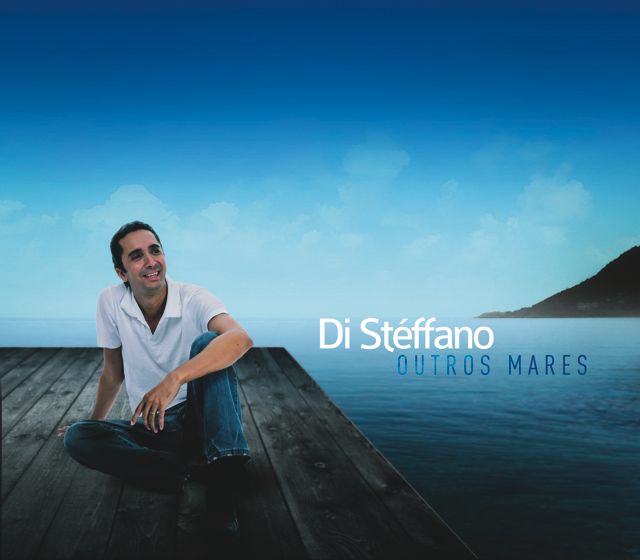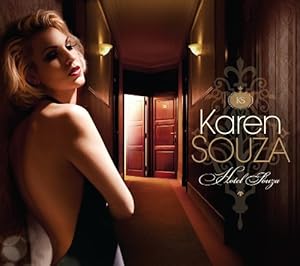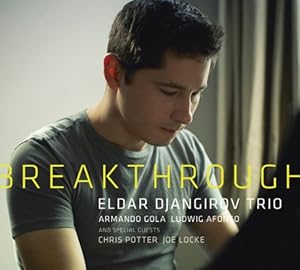Outros Mares

By Leonardo Barroso
Desde que comecei a ouvir e amar o Jazz, sempre que tenho ideias pré-concebidas sobre algum musico ou CD, esta maravilhosa arte vem e me dá um chute de realidade, aonde o Jazz é livre, belo, forte e sem barreiras.

By Leonardo Barroso
Desde que comecei a ouvir e amar o Jazz, sempre que tenho ideias pré-concebidas sobre algum musico ou CD, esta maravilhosa arte vem e me dá um chute de realidade, aonde o Jazz é livre, belo, forte e sem barreiras.
Estava eu, em uma quinta-feira, comendo um hambúrguer no Genaro Jazz Burger Café ( www.genarojazzcafe.com.br) , aqui em Brasília/DF, esperando o término da aula de Judô de meus filhos, quando chegou um dos músicos que iriam ali se apresentar, na caso o baterista Di Stéffano.
Ao terminar o lanche, fui ao encontro do musico indagando se ele iria tocar Jazz, e assim começou uma agradável e rápida conversa jazzística, e ao final ele me mostrou seu ultimo trabalho, o CD “Outros Mares“.
Eu nada conhecia sobre Di Stéffano, mas o CD mostrava alguns músicos conhecidos (André Mehmari, Arthur Maia, Hamilton Pinheiro, Marcelo Mariano, Ricardo Silveira, etc.). e fui muito desconfiado ouvir.
Esta foi uma das mais agradáveis surpresas que tive em muito tempo, “Outros Mares” é um CD de JAZZ ! O disco tem tudo para eu não gostar: todas as musicas são de autoria de Di Stéffano, foi gravado em vários estúdios (sete no total), com vários e diversos músicos. Porem tudo se encaixa nesta obra, as composições são excelentes, o padrão de gravação é perfeito ao ponto de eu não conseguir distinguir um estúdio do outro.
Que prazer em ouvir um CD de Jazz feito no Brasil, não deixando a desejar de nenhum outro feito no exterior. È um disco que merecia um selo ECM tamanha a beleza de seu todo.
Falando em ECM, na conversa que tive com Di Stéffano, comentei sobre o ultimo CD que havia me deixado da mesma forma, o do também baterista Manu Katché em “Neighbourhood” , que também é um dos favoritos do Di Stéffano.
Mostrando toda a coerência e inspiração que este grande baterista/compositor/arranjador possui, “Outros Mares” é um dos ótimos lançamentos de Jazz em 2013.
Ao terminar o lanche, fui ao encontro do musico indagando se ele iria tocar Jazz, e assim começou uma agradável e rápida conversa jazzística, e ao final ele me mostrou seu ultimo trabalho, o CD “Outros Mares“.
Eu nada conhecia sobre Di Stéffano, mas o CD mostrava alguns músicos conhecidos (André Mehmari, Arthur Maia, Hamilton Pinheiro, Marcelo Mariano, Ricardo Silveira, etc.). e fui muito desconfiado ouvir.
Esta foi uma das mais agradáveis surpresas que tive em muito tempo, “Outros Mares” é um CD de JAZZ ! O disco tem tudo para eu não gostar: todas as musicas são de autoria de Di Stéffano, foi gravado em vários estúdios (sete no total), com vários e diversos músicos. Porem tudo se encaixa nesta obra, as composições são excelentes, o padrão de gravação é perfeito ao ponto de eu não conseguir distinguir um estúdio do outro.
Que prazer em ouvir um CD de Jazz feito no Brasil, não deixando a desejar de nenhum outro feito no exterior. È um disco que merecia um selo ECM tamanha a beleza de seu todo.
Falando em ECM, na conversa que tive com Di Stéffano, comentei sobre o ultimo CD que havia me deixado da mesma forma, o do também baterista Manu Katché em “Neighbourhood” , que também é um dos favoritos do Di Stéffano.
Mostrando toda a coerência e inspiração que este grande baterista/compositor/arranjador possui, “Outros Mares” é um dos ótimos lançamentos de Jazz em 2013.
Enrico Pieranunzi
Live At The Village Vanguard

By Nat Chinen at NYTimes
One thing musicians often say about playing at the Village Vanguard, New York’s oldest extant jazz club, is that you have to make your peace with the ghosts in the room. What that means has less to do with the spirit realm than with the specters of historical memory shaped by famous recordings and firsthand experiences, and made all the more immediate by the photographic portraits on the wall.
The Italian pianist Enrico Pieranunzi has surely considered these issues, given his deep admiration for Bill Evans, who was about as closely associated with this club as anyone. But it’s likely that the connection rings clearer than usual this week as he works alongside the bassist Marc Johnson and the drummer Joe La Barbera, otherwise known as the surviving members of Evans’s last trio.
If you know that group, you probably know its brilliant, springy work on “Turn Out the Stars,” a six-CD boxed set recorded at the Village Vanguard in 1980 — a few months before Evans died, at 51 — and eventually released (on Nonesuch, in 1996) to breathless critical acclaim. And if you know those recordings, you might have had a hard time pushing them to the back of your mind during a performance this week.
But Mr. Pieranunzi, 63, is savvy enough to work with that knowledge, bending it to his purposes. He didn’t overstuff his first set on Wednesday night with songs from the Evans repertory, but neither did he try to obscure that pianist’s influence. His opening tune, “Autumn Song,” was an original with a strong whiff of the Evans style — those feathery harmonies, that nifty rhythmic modulation — and right away Mr. Johnson and Mr. La Barbera sounded almost exactly as they did in the same room more than 30 years ago.
This yielded a mildly disorienting sensation that persisted through the second tune, a coolly Evanescent waltz called “The Mood Is Good.” But what followed — “Ornettement,” for Ornette Coleman — handily broke the spell. Mr. Pieranunzi adopted a flintier, more percussive attack, and his partners edged into tougher and more irresolute territory, swinging intrepidly for a while before settling into a pop-gospel backbeat groove.
Mr. Johnson and Mr. La Barbera are still effortlessly effective as a rhythm team, and each delivered smart and punchy solo commentary. Mr. Johnson was the trio’s most consistently engaging improviser, bounding across the full register of his instrument; he was also its linchpin, the person with whom both of the other players have ample history.
Gradually the set took on its own character; by the time it arrived at a Nino Rota-esque original called “Fellini’s Waltz,” there was no doubting that Mr. Pieranunzi was in control.
Which may have been all the assurance he needed to tip his hat: first with a spare but sumptuous interpretation of “These Foolish Things,” and finally, during the encore, with “Solar,” one of the jazz standards Evans explored often in his final years. It was tackled here with emphatic license, even if it ultimately felt like an offering.
Edward Simon Trio
Live In New York At Jazz Standard

By John Kelman
Some artists maintain a busy release schedule, putting out an album a year—sometimes, in the case of musicians like guitarist Bill Frisell, even more frequently—while others, for a variety of reasons, are less prolific. Pianist Edward Simon has, in recent years, been issuing albums with broader distribution under his own name—which automatically discounts 2010's independently released but undeniably fine Danny Boy—about once every three years on labels ranging from The Netherlands' Criss Cross to Italy's Cam Jazz. Live in New York at Jazz Standard is the third in a consecutive string of recordings to feature his seven year-old trio with bassist John Patitucci and ubiquitous drummer Brian Blade, but it's both his first live recording and the first to be issued on the American Sunnyside imprint. Sometimes, making your fans wait is a good thing; in this case, Simon's set, recorded at New York's Jazz Standard—drawing primarily from Unicity (Cam Jazz, 2006) and from Poesia (Cam Jazz, 2009), but also containing a surprise or two—has unequivocally been worth the wait, and continues to position the ever-inventive pianist as one of his generation's most watch-worthy.
In a recent discussion with Richie Beirach, the pianist suggested that one of the characteristics of "real improvisers" is being motif-driven and, while his statement might be a controversial one that will engender plenty of discussion and debate, it certainly fits Simon's approach. Whether soloing in the somewhat more constricted (time-wise) confines of the recording studio or stretching out as he does here, Simon has always been a thoughtful player whose solos often build from evolving motifs; cerebral, even, but as evidenced on tunes like the irregularly metered, Latin-esque "Pere"—the modal set-closer, drawn from a much earlier collaboration with saxophonist David Binney, Afinidad (RED, 2001)—the pianist proves that music of the head need not preclude the heart, as his solo builds, carefully, considerately, inevitably, to its climactic conclusion before settling into an ostinato-based feature for Blade, a name for whom the term "incendiary" has always been a synonym. Dynamic, but peppered with thunderous crashes and audible whoops and hollers, Blade's as unfettered as it gets—a player, in some ways, the antithesis of Simon in his almost entirely instinctive approach—and, perhaps, the very reason they work so well together.
Patitucci—whose early years were spent largely in fusion and near-smooth jazz territory with artists like pianists Chick Corea and David Benoit, and saxophonist Eric Marienthal—has completely reinvented himself over the past decade, largely through his work in saxophonist Wayne Shorter's quartet (also with Blade), heard recently on the exploratory excellence of Without a Net (Blue Note, 2013). Here, he proves himself equally imaginative, whether swinging with unrelenting fervor on Simon's set-opening title track from Poesia, or contributing soaring arco to the more abstract terrain of the pianist's "Pathless Path," from Unicity, stretched here to nearly three times its original length. Bookended by a first-time look at Antonio Carlos Jobim's "Chovendo na Roseira"—beginning with an a cappella pizzicato solo from Patitucci that leads to a more pulse-driven but still ethereal reading, only settling into more recognizable reverence halfway through its nearly 14-minute duration—and Simon's ambling take on saxophonis John Coltrane's change-driven rite of passage, "Giant Steps," first heard on Poesia, "Pathless Path" becomes the dramatic centerpiece to Live's hour-long set.
Simon remains a busy player, in particular with his ongoing work as a member of the SFJAZZ Collective, last heard live and on record performing the music of soul legend Stevie Wonder, and in the Ninety Miles (Concord, 2011) touring band, with vibraphonist Stefon Harris, saxophonist David Sanchez and trumpeter Nicholas Payton (replacing the album's Christian Scott), which clocked considerable road time in 2012 includinga terrific stop at the TD Ottawa Jazz Festival. He may not release his own albums as often as some might like, but when a record like Live in New York at Jazz Standard comes along—a stellar date that combines head and heart, mainstream and more eclectic concerns, and appealing, broad-reaching originals with distinctive arrangements of well-known standards, all played by a trio clearly at the top of its game—then all is forgiven and, while waiting for Simon's next release, there's a growing discography with one more fine entry to return to, time and again.
Track Listing:
Poesia; Chovendo na Roseira; Pathless Path; Giant Steps; Pere.
Personnel:
Personnel:
Edward Simon: piano; John Patitucci: bass; Brian Blade: drums.
Holly Cole
Night

By Mike Doherty
The most interesting people, Holly Cole says, are “bundles of contradictions.” Curled up on her living room couch in downtown Toronto, she’s talking specifically about avant-blues iconoclast Captain Beefheart, whose song Love Lies she covers on her new album,Night — but she might as well be describing herself.
The Halifax-born chanteuse grew to fame in the early ’90s as a seemingly old-fashioned, long-glove-wearing interpreter of standards who nonetheless would often subvert the songs she sang. On her debut album, Girl Talk, she belted out the title track as an exaggerated parody of dated, sexist mores, and she delivered the vivacious Petula Clark anthem Downtown as if it were called Downcast. The practice continues on Night, as she sings Viva Las Vegas (of Elvis Presley fame) from the point of view of someone rather jaded: “There’s part of you that really loves [Vegas], but you know what’s coming: the guys with diapers and people who’ve been up for three days and have sold their daughter’s college fund.”
Subtext, she says, is her “best friend,” but her knowing approach leaves room for genuine-sounding emotion, and Night comes across as a personal collection indeed. In part, it’s a love letter to the wee hours, her “most creative time.” Her earliest memory is of her father, CBC broadcaster Leon Cole, taking her out into the misty Maritime air at 4 a.m., when she was three years old, to calm a cough: “There’s no people, and nothing there under the moonlight and the hazy street lights … I felt like I had the most beautiful and amazing secret.” Many of Night’s lyrics are set after dark, and they also tend (Elvis aside) to be introspective.


















